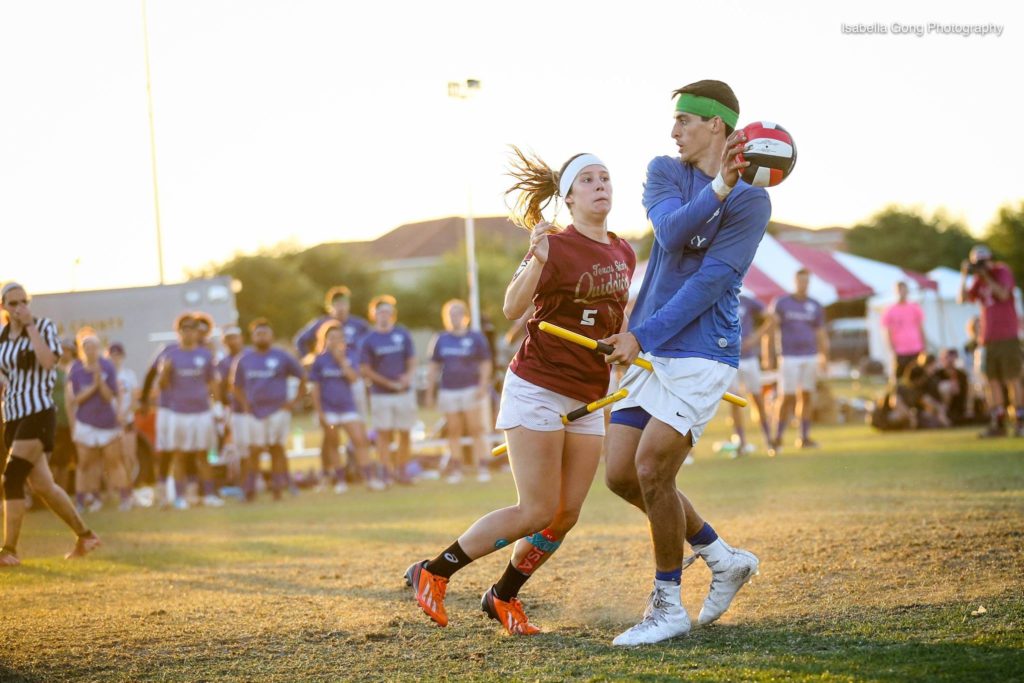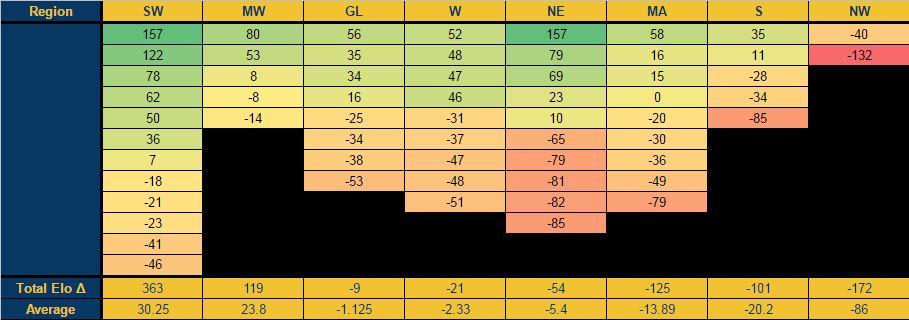- Rule, Britannia, no more?
- Unpopular Opinions: US Quadball Cup 2023
- Proven Contenders: University of Virginia
- Proven Contenders: Rutgers University
- Proven Contenders: University of Michigan
- Proven Contenders: Creighton University
- Different Perspectives: A Look Inside USA Ultimate
- Antwerp QC, Much of Belgian Core, Leaves Competitive Quidditch
T8M Elo Rankings – 5/10/17
With US Quidditch Cup 10 in the books, we’d like to take an Elo-focused look back on the tournament and where teams rank at the end of the season.
There is little surprise that after all is said and done, Texas Cavalry finds themselves on top with the fifth highest season-ending Elo of all time at 2107. Texas State University, the other finalist, ends with a similarly impressive rating of 2022, the 10th best season-ending Elo of all time and the third best ever recorded by a college team. Despite being a finalist, however, Texas State still ends the season with a lower rating than Quidditch Club Boston (2049) and Rochester United (2024). With their quarterfinal finishes, both Rochester and Boston are the only two teams to ever finish the season with an Elo rating above 2000 without making the national semifinals. Rochester’s quarterfinal opponent, Mizzou, ends the season ranked sixth in Elo, with a rating of 1938, while Boston’s quarterfinal opponent, the BosNYan Bearsharks, end the season ranked 17th, with an Elo rating of 1792. At 17th, BosNYan achieves their own superlative, becoming the lowest-ranked team (in Elo) to ever make the semifinals, a spot they steal from the 2013 Bowling Green State University team, who finished ranked 13th overall, and the 2014 Texas State and 2016 Ball State University teams, who both finished ranked ninth overall.
Tournament Elo Change
The spreadsheet linked here shows the Elo ratings of all 60 teams before Cup, after day one and after each round of bracket play, complete with the changes of each round and sorted by total tournament Elo change. It is unsurprising to see the winner, Texas Cavalry, and the BosNYan Bearsharks, who defeated four regional champions with Elo ratings higher than 1900 at the top of this list, followed closely by the tournament runner up, Texas State. Because our Elo ratings readjust after each round of bracket play–with winners gaining and losers dropping points–as a team goes further into bracket play, their opponents get higher, on average, in Elo. This conceptually makes sense, as the further a team goes, the more valuable each game will be, which bears out in the Elo ratings.
Our Elo rating system also takes into account the margin of a win. Thus, BosNYan’s 160*-80 major upset of Lone Star Quidditch Club resulted in the largest Elo change of any game at this tournament, a 62-point boost for BosNYan (as well as a 62-point drop for Lone Star). This single game gave BosNYan a higher jump in our Elo ratings than most teams saw over the entire tournament–in fact, only seven teams had a higher jump over all.
The worst team performance, according to Elo change, comes from Utah State Quidditch Club, who lost a whopping 132 points from their rating. It is hard to say, however, how accurately this adjustment reflects the strength of their team, as their keeper, Cameron VomBaur, was suspended for three of their four pool play games due to their team wearing the Northwest Regional Champion medals during the opening ceremony. Keeper Garrett Elmy was also suspended for their first game due to an infraction that occurred at the Northwest Regional Championship. While it is hard to say exactly how large an effect the presence of VomBaur or Elmy would have had on the team’s performance if they had been allowed to play those games, it is evident in the team’s uncharacteristically large drop in Elo that their absence was a significant loss for Utah State.
Close observers will note that certain games resulted in an uneven swing of Elo ratings for some teams. For example, BosNYan’s win over the University of Maryland in the round of 32 boosted BosNYan’s Elo by 29 points, while only dropping Maryland’s by 28. This is because our Elo is calculated at a decimal level, but is then rounded to whole numbers for public viewing. Thus, fractional changes in Elo that occur during games may show differences of plus or minus a point, depending on what the exact starting Elo rating was of each team.
Teams at their Best
Of the 56 non-first year teams that competed in US Quidditch Cup 10, 20 finished the year with a higher, or tied for higher, Elo than any of their previous seasons. Thus the following teams can be considered the “defining team” for their programs or the best iteration of that team that has ever existed:
Texas Cavalry, Texas State, Mizzou, Los Angeles Gambits, Bowling Green, RPI, University of Kansas, DCQC, Florida’s Finest, Rutgers University, Arizona State University, Gulf Coast Gumbeaux, The Warriors, Cal, UTSA, Long Beach Funky Quaffles, Silver Phoenix, Macaulay Honors College, Indiana University and Anteater Quidditch
Regional Rearrangement
One of the greatest aspects of our national tournament is that it allows teams to break out of their regional bubbles and compete against opponents from across the country. When viewed at a tournament level, this interregional play can provide a valuable look at which regions had overinflated Elo ratings this season and which regions’s were chronically underrated. The simplest way to do this is to sum the Elo change of the teams from each region and then divide that by the number of teams from that region. While hard to estimate on a team-by-team basis, it does give us a good look at where Elo ratings were misallocated this season. It is unsurprising then to see the Southwest at the top of this list with an average Elo gain per team of just over 30 points. The Southwest average is bolstered largely by Texas Cavalry and Texas State, two of three teams at the tournament whose ratings rose by over 100 points this weekend. The Midwest was the only other region with a positive Elo change at Cup, bolstered by the strong performances of Mizzou (+80) and Kansas (+53). With both teams setting program Elo records, it remains to be seen if this is a standalone year for the Midwest or the beginning of a new trend of relevance for USQ’s newest region.
At the bottom of this list lies the South (-20 points per team) and the Northwest (-86 points per team), two regions whose teams’s Elo ratings were very evidently overinflated this season. While some of the Northwest’s drop was due to Utah State’s somewhat artificial plummet, they would have had to have broken even to have kept the Northwest off the bottom of this list. While the absence of a player may result in an artificial Elo drop, it is rare to see any one player have a 132-point effect on their team’s Elo performance.
One surprise on this list is the Northeast, who put more teams in the quarterfinals than any other region (four) and yet still ended the tournament with a negative regional Elo average. Although the top teams in the region performed well, the Northeast saw five teams go 0-4, giving them five of the eight worst Elo performances at Cup. Thus, half of the teams at the tournament who went 0-4 were Northeast teams, four of whom, according to pre-tournament rankings, had less than a 10 percent chance of doing so. While this weekend could certainly be seen as a triumph for the Northeast, it can just as easily be seen as a failure, depending on how deep your perspective goes.
Facts and Stats
- Going into bracket play, the BosNYan Bearsharks had a 0.79 percent chance of making the semifinals yet did so with three straight wins over teams with an average Elo of 269 points greater than theirs.
- With a final rating of 1931, Bowling Green is the only team to exactly tie their season ending Elo from last season.
- Despite the Gambits reaching their program’s highest season-ending Elo (1937), this is the only time in their three-year history that they have failed to make the Sweet 16.
- The Warriors, who entered nationals with an Elo of 1725, are the only team to leave the tournament with the exact same rating, earning The Eighth Man’s first annual “Achieved Expectations Award.”
- Finishing with respective Elo ratings of 2024, 1960 and 1926, Rochester United, Lone Star and the University of Texas remain the only three programs to finish with average season-ending Elo ratings greater than 2000.
- Rochester: 2030
- Lone Star: 2029
- Texas: 2008
- Cavalry’s final Elo of 2107 is the fifth highest of all time, coming in behind 2015’s Texas (2161), 2015’s Lone Star (2134), 2016’s Boston (2122) and 2016’s Lone Star (2111).
- Seven of this year’s top ten teams finished there last year: Cavalry, Missouri and Maryland replace University of Michigan, the Lost Boys and Ball State. However, this lack of turnover is roughly average. In the five years our Elo ratings track, only 23 programs have finished in the top 10, seven of which have only done so once. Texas is the only team to have done so five times, while Texas State, Lone Star, Maryland and the Lost Boys each have four top-ten finishes, and the Gambits, Baylor University and Boston all have three.
Related Posts
About Joshua Mansfield
A native of Cincinnati, Ohio, Joshua Mansfield began playing quidditch when he founded the Tulane University team in 2013. He currently plays for Texas Hill Country Heat and serves as the Gameplay Director for Major League Quidditch. Additionally, he is the third-largest consumer of cilantro in the greater New Orleans area.





